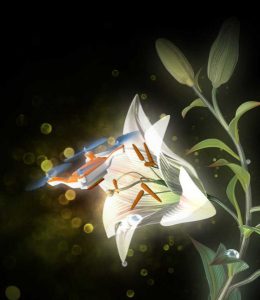Researchers say swarms of tiny drones could take the sting out of a troubling international downside – the collapse of bee populations.
According to the United Nations Food and Agriculture Organization, 71 of the 100 crops that account for nearly all the world’s meals provide depend upon bee pollination. Over the final 12 months, 44 % of the business bee inhabitants mysteriously died out. Without bees, we’re in hassle.
And whereas the thriller of dying colonies will not be resolved any time quickly, scientists are growing drones that may pollinate flowers. In a lately revealed paper, a group led by chemist Eijiro Miyako of Japan’s National Institute of Advanced Industrial Science and Technology report that the utility of horse hairs and ionic gel to an “off-the-shelf $100 quadcopter” can efficiently mimic bee pollination throughout a species of Japanese lilies.
Because a bigger swarm of drones can now be managed by a single consumer (or an autonomous program), bee-like drones at the moment are a risk moderately than a sci-fi state of affairs.
“The findings, which will have applications for agriculture and robotics, among others, could lead to the development of artificial pollinators and help counter the problems caused by declining honeybee populations,” Miyako stated in a press launch. “We believe that robotic pollinators could be trained to learn pollination paths using global positioning systems and artificial intelligence.”
The key to the Institute’s profitable experiment comes right down to the ionic gel. Miyako created the gel in 2007 for use on electrical parts. He thought-about the concoction a failure and it languished in a storage closet. A couple of years later, Miyako started to marvel if his gel may very well be used to hold pollen.
“This project is the result of serendipity,” says Miyako, who labored with postdoctoral fellow and first creator Svetlana Chechetka. “We were surprised that after 8 years, the ionic gel didn’t degrade and was still so viscous. Conventional gels are mainly made of water and can’t be used for a long time, so we decided to use this material for research.”
 Unmanned Aerial Vehicle The latest drone news
Unmanned Aerial Vehicle The latest drone news




